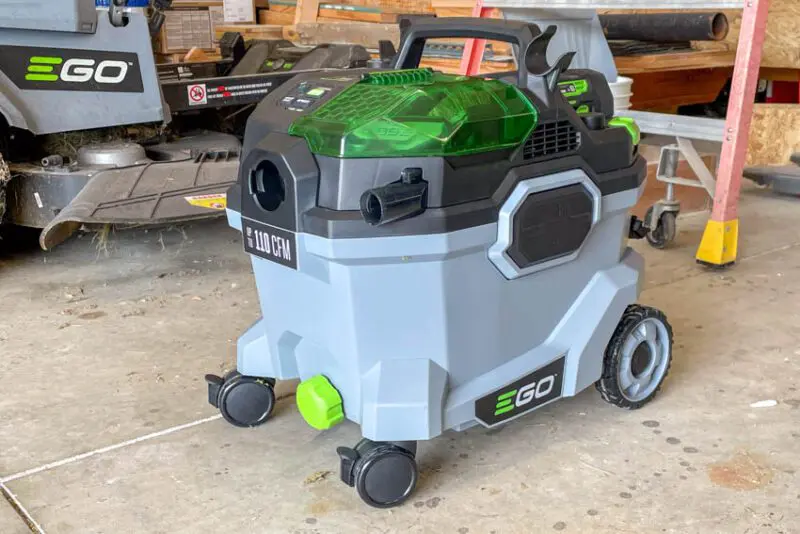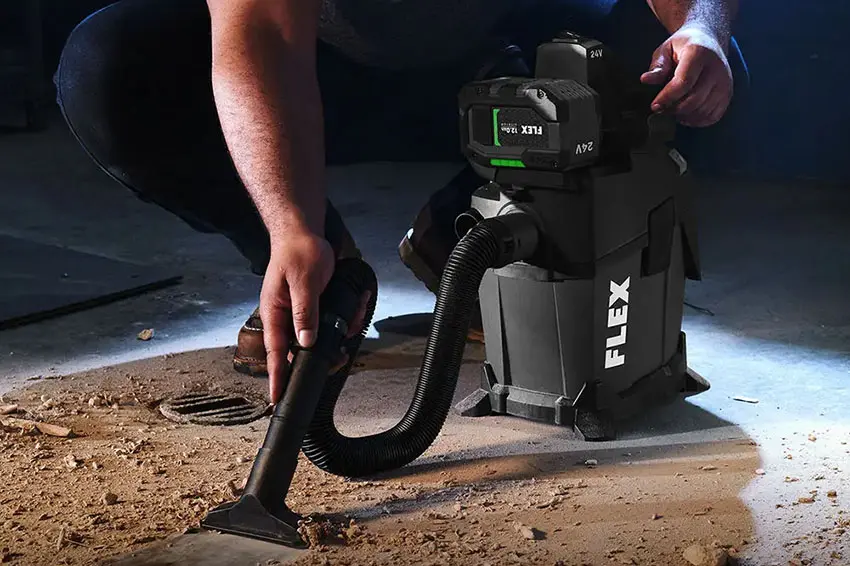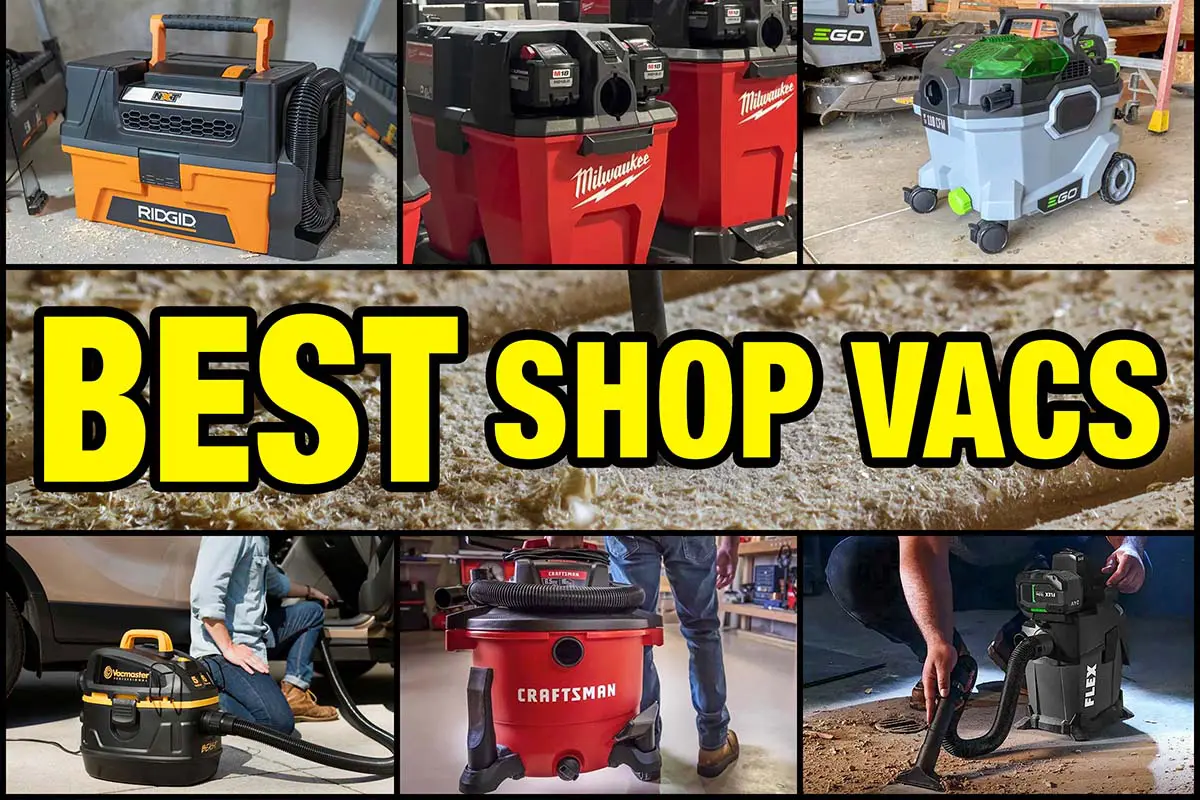At Pro Tool Reviews, we’re constantly testing tools (it’s in the name), which means we also have a lot of cleanup to do around the shop. This provides us with a great opportunity to evaluate the best shop vac brands and models available.
While there are dozens of options that can get the job done, some wet-dry vacuums prove to be better than others. In this roundup, I’ll share the ones that stand out from the competition and help you find the right one for your needs.
Best Shop Vac Top Picks
- Best Overall: Milwaukee Modular Wet-Dry Vacuum System
↓ Jump to this Shop Vac - Most Powerful: EGO 56V 9-Gallon Wet-Dry Vacuum
↓ Jump to this Shop Vac - Best Cordless: EGO 56V 9-Gallon Wet-Dry Vacuum
↓ Jump to this Shop Vac - Best Small: Flex24V 1.6-Gallon Wet-Dry Vacuum
↓ Jump to this Shop Vac - Best for Car Detailing: Vacmaster Beast 5-Gallon Wet-Dry Vacuum
↓ Jump to this Shop Vac - Best for Dust Collection: Craftsman Heavy-Duty 16-Gallon Wet-Dry Vacuum
↓ Jump to this Shop Vac - Best for the Money: Ridgid Wet-Dry Vacuums
↓ Jump to this Shop Vac
Want More Information Before You Get Started? Jump to These Sections First!
- How We Make Our Choices
- What is a Shop Vac and Why Do You Need One?
- Corded vs Cordless
- Most Important Things to Look For While You’re Shopping
- Why You Can Trust Pro Tool Reviews
Best Shop Vac Overall

Milwaukee Modular Wet-Dry Vacuum System
- Capacity: 6, 9, or 12 gallons
- Peak HP: 3.5 – 6.5 HP
- Airflow: 87 – 145 CFM
- Water Lift: 60 – 88 inches
- Hose Diameter: 1 7/8 or 2 1/2 inches
Pros
- Customizable to fit your needs
- Excellent performance
- Outstanding build quality
- Effective hose and accessory storage
- Deep line of trade-focused accessories
- Cordess models are compatible with all Milwaukee M18 batteries
Cons
- Cordless models require battery runtime management
- Expensive
The best shop vac overall has to have the best balance of everything, and Milwaukee nailed it, but not with just one vac. They created an entire modular system that lets you customize what you need. Choose from single-battery, dual-battery, or corded powerheads. Then add a 6, 9, or 12-gallon canister and the cart if you need rolling capability. From there, you can go with a standard filter, wet foam filter, or HEPA filter.
Milwaukee’s product team also developed a trade-focused line of Air-Tip accessories that are cross-compatible with almost any hose size.
While there’s not just one vac that fits every need, Milwaukee has designed a system that is far greater than any one model thanks to the sum of its parts.
| Airflow | Water Lift | Peak HP | |
|---|---|---|---|
| M18 Fuel Model 0911 | 87 CFM | 60 inches | 3.5 HP |
| M18 Fuel Dual Battery Model 0921 | 109 CFM | 77 inches | 4.25 HP |
| Corded Model 0931 | 145 CFM | 88 inches | 6.5 HP |
Price: $189 – $199 motorheads, $79 – $99 canisters, $79 rolling cart (various kits also available)
Most Powerful and Best Cordless Shop Vac

EGO 56V 9-Gallon Wet-Dry Vacuum
- Capacity: 9 gallons
- Motor: 56V brushless
- Airflow: 110 CFM
- Water Lift: 100 inches
- Hose Diameter: 1 7/8 inches
Pros
- Most powerful model we’ve tested
- Better build quality than low-priced models
- Effective hose and accessory storage
- Cordless freedom
- Compatible with all EGO 56V batteries
Cons
- You have to manage battery runtime
- Expensive
While many brands did good work converting wet-dry vacuums to battery power but traded off performance, EGO’s team seemed to ask… what can we do because it’s cordless? The answer is the most powerful shop vac we’ve tested, corded or cordless. With EGO’s 56V battery as a power source, it can deliver high airflow and water lift, making it a good fit for nearly every need. Plus, it’s a more durable build than cheaper models you may be considering.
The downside is that batteries don’t run forever, and you’ll have to manage how you use the power you have for jobs that take longer to complete. Of course, that’s the case with every cordless vacuum.
Price: $299 bare, $499 kit with a 5.0Ah battery
Best Small Shop Vac

Flex 24V 1.6-Gallon Wet-Dry Vacuum
- Capacity: 1.6 gallons
- Moto: 24V brushless
- Airflow: 41 CFM
- Water Lift: 42 inches
- Hose Diameter: 1 1/4 inches
Pros
- Strong performance compared to other compact models
- Cordless freedom
- Small storage footprint
- Compatible with all Flex 24V batteries
Cons
- Limited collection capacity
- You have to manage battery runtime
Price: $129 bare
When you’re looking for a handheld vac that’s more capable than the one your mom used to have attached to the wall, I really like what Flex offers. Compared to other small vacs, the performance is higher and is balanced between airflow and water lift. I like that the canister holds more and the hose can reach into deeper, tighter spaces than one-piece units. Its small storage footprint is also appealing.
This vac is great for quick cleanup in relatively small areas, but its performance isn’t going to knock off larger models. That’s something to keep in mind if your priorities include dust collection for benchtop tools or cleaning up heavier debris.
Best Shop Vac for Car Detailing

Vacmaster Beast 5-Gallon Wet-Dry Vacuum
- Capacity: 5 gallons
- Peak HP: 6.0 HP
- Airflow: 102 CFM
- Water Lift: 82 inches
- Hose Diameter: 1 7/8 inches
Pros
- Outstanding performance for its size
- Easily to transport and carry
- Reasonably small storage footprint
Cons
- Moderately limited storage capacity
- Requires a nearby power source
To effectively detail vehicles, you need a small enough vacuum to get inside yet strong enough to help lift dirt out of the carpet. No model does that better than the Vacmaster Beast 5-gallon wet-dry vacuum. Not only is its overall performance higher than others in its size class, but its water lift is significantly stronger than its competitors as well.
In a perfect world, I’d love to have a cordless model to make mobile detailing more convenient, but you won’t find one that also has Vacmaster’s combination of size and performance.
Price: $109.99
Best Shop Vac for Dust Collection

Craftsman Heavy-Duty 16-Gallon Wet-Dry Vacuum
- Capacity: 16 gallons
- Peak HP: 6.5 HP
- Airflow: 190 CFM
- Water Lift: Not listed
- Hose Diameter: 2 1/2 inches
Pros
- High airflow for collecting dust
- High capacity
- Good value
Cons
- Not as easy to transport
- Can be heavy when full
- Large storage footprint
High airflow and capacity are the key to the best performance when it comes to dust collection. Craftsman nails it with a 16-gallon shop vac that hits an impressive 190 CFM. Whether connected directly to the tools you’re using or cleaning up your work area when you’re finished, it has higher airflow than any of the other vacs I considered.
If you want even more capacity, there’s also a 20-gallon model. The trade-offs are that It has slightly lower airflow, an even larger storage footprint, and is more expensive. If you have the room and budget for it, it’s another excellent option, though.
Price: $139.99
Best Shop Vac for the Money

Ridgid Wet-Dry Vacuums
- Capacity: 3 – 16 gallons
- Peak HP: 3.5 – 6.5 HP
- Airflow: 62 – 161 CFM
- Water Lift: Not listed
- Hose Diameter: 1 7/8 – 2 1/2 inches
Pros
- Excellent value
- Tends to have high CFM for their size class
- Wide range of performance levels and size
- Corded and cordless vacuums available
- Cordless models use the same batteries as Ridgid 18V power tools
Cons
- Tends to have lower water lift than others in their size class
If you pay attention to contractors’ trucks while you’re driving, you’ll likely see more Ridgid wet-dry vacuums than any other brand. They’re an excellent value and tend to cost less than competing models in the same size and performance class. Plus, they’re conveniently available at Home Depot.
Ridgid vacs usually prioritize higher airflow, so they typically have higher CFM values than their competitors. It’s a trade-off, though, and the water lift values tend to be a little lower. They’re still very capable, so don’t let that scare you off unless you’re looking for the highest water lift strength available.
Did you know? Ridgid vacuums are made by Emerson, not the TTI brand who manufacturers Ridgid power tools.
More Shop Vac Recommendations from Brands We Trust
DeWalt Stealthsonic Wet-Dry Vacuums
- Capacity: 6 – 16 gallons
- Peak HP: 4.0 – 6.5 HP
- Airflow: 85 – 135 CFM
- Water Lift: 68 – 75 inches
- Hose Diameter: 1 7/8 – 2 1/2 inches
One of the reasons I like DeWalt’s shop vacs is that they have better build quality than other models we’ve used. With the upgrade to the Stealthsonic line, they now have quieter operation as well. The performance levels are mid-range compared to the competition.
Note: There are “QT” and “QTA” versions available. The “QTA” models include a contractor’s kit with upgraded gear and a higher price point.
Price: $80 – $300
Greenworks 60V Hybrid 9-Gallon Wet-Dry Vacuum
- Capacity: 9 gallons
- Motor: 60V max brushless
- Airflow: 90 CFM
- Water Lift: 30 inches
- Hose Diameter: 1 7/8 inches
Greenworks has one of the few hybrid shop vacs that can operate on either battery or corded power. While its water lift strength is relatively low, the airflow is excellent, making it a good choice for lightweight debris.
Note: Greenworks also has a solid corded 9-gallon model with 105 CFM/88 MPH suction performance if you don’t need cordless operation.
Price: $250 bare tool
Hilti VC 300-17 X Dust Extractor
- Capacity: 17 gallons
- Peak HP: HP
- Airflow: 300 CFM
- Water Lift: 102 inches
- Hose Diameter: 36mm (1.4 inches)
Hilti’s wet-dry vacuums are purpose-built for construction applications and fit in the dust extractor category. If you want the mother of all vacs, the VC 300-17 X has the suction power to stop the earth’s rotation. Okay, not really, but with 300 CFM and 102 inches of water lift it’s a serious sucking machine. It’s one of few vacuums that can reliably maintain dust extraction on multiple tools and is Table 1 compliant.
Note: This vacuum requires a 20-amp outlet to run on 110V circuits.
Price: $2579
Makita 40V max X2 (80V) XGT 10-gallon HEPA Wet-Dry Vacuum
- Capacity: 10 gallons
- Motor: 80V max brushless
- Airflow: 173 CFM
- Water Lift: 72 inches
- Hose Diameter: 1 inch
Makita vacuums don’t include models in the traditional shop vac space. Instead, they cater to professionals with high-end dust extractors. If you’re into professional woodworking, Makita’s 40V max XGT 10-gallon vac is compelling. With AWS, it can automatically turn on and off as you use compatible AWS tools. That system includes miter saws,a track saw, and much more, giving woodworkers cordless freedom that doesn’t compromize performance.
Price: $1499 bare, $1079 kit with two 4.0Ah batteries
Ryobi 18V One+ Link Wet-Dry Vacuum PCL734
- Capacity: 3 gallons
- Motor: 18V brushless
- Airflow: 50 CFM
- Water Lift: 46 inches
- Hose Diameter: 1 1/4 inches
Ryobi’s 3-gallon PCL734 is a great little vacuum to keep around the garage and house. While its performance isn’t as high as larger models, it’s balanced well between airflow and water lift, making it ideal for all kinds of quick cleanup jobs. Plus, it’s Link-compatible if you’re using Ryobi’s modular organization system and has a clever accesory storage design.
Price: $129 bare, $179 kit with a 4.0Ah battery
Shop-Vac 14-Gallon Wet-Dry Vacuum with SVX2 Motor Technology
- Capacity: 14 gallons
- Peak HP: 6.5 HP
- Airflow: 150 CFM
- Water Lift: 72 inches
- Hose Diameter: 2 1/2 inches
What good would a best shop vac roundup be if we didn’t include the Shop-Vac name? From the brand that defined the class, I like the high-capacity SVX2 models, and I’d go with the 6.5 HP 16-gallon model. It has high performance and capacity, making it a solid choice as an all-around wet-dry vacuum.
Note: If you’re a little short on space, consider the 14-gallon model to keep the performance while shrinking the storage footprint it needs.
Price: $210
How We Make Our Choices
Best Overall
To be the best of the best, we’re looking for high performance, a quality build, and as much versatility as a wet-dry vacuum can have. Price doesn’t come into play.
Most Powerful
When we think of wet-dry vacuum power, water lift is the most important factor since the higher it is, the heavier the debris it can get moving. CFM is secondary and all other priorities are less important.
Best Cordless
Similar to our requirements for best overall, it’s primarily about performance, build, and versatility, and it has to get its peak performance using a battery for power.
Best Small
For the best small wet-dry vacuum, we’re looking for the best performance we can find from a model that’s easy to carry in your hand, including when it’s full. Build quality and features are secondary.
Best for Car Detailing
For car detailing, we’re looking for a vacuum with a small-ish form factor that’s less than 6 gallons so that it’s easy to transport for mobile detailers. We want the top performance for the size and the highest water lift, which is important to help dig dirt out of carpet.
Best for Dust Collection
Since sawdust is so light, we look for the highest airflow (CFM) ratings to move debris quickly into the canister. Clearing dust and small chips fast is important when you’re trying to keep power tool dust ports from clogging. High capacity is also a priority, so we spend less time emptying the canister when there’s a lot of sawing or cleanup to do.
Best for the Money
To get the best value, we’re looking for a combination of high performance, build quality, and features, all at the best possible price. We’re not looking for cheap, though. We expect our wet-dry vacuums to work hard and last for a long time.
What is a Shop Vac? Why Do You Need One?
Shop-Vacs are like Kleenex, Bandaids, and Sawzalls. The Shop-Vac brand became so synonymous with wet-dry shop vacuums that people started calling all of them Shop-Vacs. The Shop-Vac brand is still around, though. It went through a rough period before being sold to Great Star Tools in December 2020, but you can still buy them at several major retailers.
So, for our purposes, a shop vac is a wet-dry vacuum.
Their function is in the name. These vacuums excel at cleaning up both wet and dry messes using airflow and a variety of nozzles. Professional contractors, tradesmen, DIYers, and homeowners can all find a need to own one. You can collect dust from tools, clean out your car, suck up the water from an overflowing toilet, and so much more.
However, they are quite different from the dust extractors you find on jobsites or the upright vacuums you use to clean your home.
Compared to dust extractors, shop vacs don’t normally have canisters that are sealed as well, arrive HEPA-certified (though some do), have automatic filter cleaning mechanisms, or as high a build quality. They’re not Table 1 certified, so using them for concrete applications is out.
Stacking up against your upright vacuum, wet-dry vacs rely on air movement for debris removal and don’t have the automatic brushes you need for regular carpet cleaning. They have brush nozzles, but you’ll need to agitate the carpet manually to work the dirt up. Of course, your upright vacuum is also far easier to maneuver around your home.
Corded vs Cordless Shop Vac
Reasons to Go Cordless
- No need to find an outlet or drag a cord
- They work on the same batteries as power tools or lawn care equipment
Reasons to Go Corded
- Unlimited runtime
- Higher performance in most cases
- Higher available capacity
- Less expensive
Deciding whether a corded or cordless wet-dry vacuum is best for you boils down to how you’re going to use it.
There’s no question that cordless models are far more convenient. You don’t have to find an outlet or drag a cord around. Most power tool brands have options that work on the same batteries as their power tools, so you don’t have to buy into a new battery system.
On the other hand, corded models typically have higher performance, unlimited runtime, larger canister capacities, and are less expensive.
The key word here is “typically”. EGO shook things up with the launch of its cordless shop vac, and it has higher power than nearly any corded model. Milwaukee also challenged the norm with its cordless motorheads that you can pair with canisters up to 12 gallons.
Then there’s Greenworks. Their 60V hybrid vacuum can run on batteries or AC power and has legit mid-range airflow.
If you have the budget, these cordless models might eliminate your need for a corded one.
What to Look For When You’re Shopping for a Shop Vac
Peak Horsepower vs CFM vs Water Lift
Peak HP
Of the three key specifications on a wet-dry vacuum, peak horsepower is the least helpful. It’s a rating of the motor, and frankly, the amperage would be more helpful. But the industry settled on peak horsepower, so we have to work with that.
Think of peak horsepower as a very broad power rating to give you a starting point. How the vac is built around it determines how much cleaning power you have to work with.
Airflow (CFM)
As an acronym, CFM stands for “cubic feet per minute.” This measure of airflow defines the amount of air flowing through the nozzle each minute. The higher the CFM, the more air it pulls through the hose.
Practically, airflow keeps debris moving once it is moving. Just because a vacuum has a high CFM rating doesn’t mean it has the power to move heavier objects like nuts and bolts. If there’s not enough suction power (water lift) to get the object moving, all the CFM in the world won’t make it budge.
Water Lift (Suction Power)
Water lift (typically measured in inches) helps us understand the vacuum’s ability to move heavier objects. In other words, it’s the muscle that gets debris moving. The higher the water lift, the greater the suction power and the heavier debris it can move.
If you’re primarily collecting sawdust, it’s really lightweight and you don’t need a ton of water lift to get it moving. If your debris involves chips of materials or nails and screws, you need more.
Canister Capacity
The capacity you need depends upon the application for your shop vac. When comparing similar models, factor in the amount of material or liquid the shop vac can hold.
Keep in mind that shop vacs measure capacity by the overall size of the canister. The filter takes up part of the room, so the dry capacity is smaller. The wet capacity is even smaller to avoid the risk of pulling water up into the motor. Most quality models have a float valve to close off the motor when the water level gets high enough.
Pro Tip: Models with higher capacity often have higher performance.
Portability
Not every wet-dry vacuum looks like a “portable” tool, but even larger units need to be transported to where the work is. Consider the weight, wheel quality, handle, and more to understand which models present the best portability for maneuvering and transport.
Pro Tip: When you drag your vacuum around by the hose, it can create cracks and tears in the material that reduce the suction performance. Extend the life of your hose by moving the vac by its handle instead.
Accessory Storage
Accessory storage consistently presents a problem for some wet-dry vacuums. No matter how much attention manufacturers pay in this area, it seems you can’t help but snag a hose or drop a nozzle. Some vacuums, however, at least address accessory storage in a way that gives you a fighting chance to ensure those nozzles and extension wands are there when you need them.
On some larger models, you can store most, if not all, of the accessories inside the canister when they are not in use. My personal preference is to store the accessories on the outside where I can easily access them. The best vacuums permit this while securing them so they do not easily fall off when you roll over a threshold.
Cord Management
Many shop vacuums include some form of cord wrap, but some are better than others. Consider how easily the shop vac manages the cord when you plug it in and when you’re done for the day.
I like dedicated cord wraps and integrated end clips that actually work (most don’t).
Price and Value
For many folks, setting a budget is the first step to eliminating options due to price. Consider the price of the vacuum and weigh it against the performance and features of the tool along with the warranty, depth of line (for cordless products), included accessories, and other priorities you may have.
I don’t really set a price point as an ideal, but I do want to trust that the company will have replacement bags and accessories for years to come. A great deal on a cheap Amazon shop vac that will be completely unavailable two years later doesn’t do me any good.
Why You Can Trust Pro Tool Reviews
Ever check out a “review” site, and you can’t tell if they actually tested the product or if they’re just “recommending” the Amazon top sellers? That’s not us. We won’t recommend anything unless we’d use it ourselves, and we don’t care who the primary retailer is. It’s all about giving you a legitimate recommendation and our honest opinion of each product.
Since 2008, Pro Tool Reviews has provided in-depth tool reviews, buying guides, how-to articles, and industry news in the construction and lawn care industries. We focus on professionals in the trades, and our writers have the skills and experience to know whether a tool or accessory will hold up on the jobsite.
Each year, we bring in and review more than 250 individual products. Additionally, our team will put their hands on hundreds more tools at media events and trade shows throughout the year. When we recommend a shop vac, that means we’d use it ourselves.



